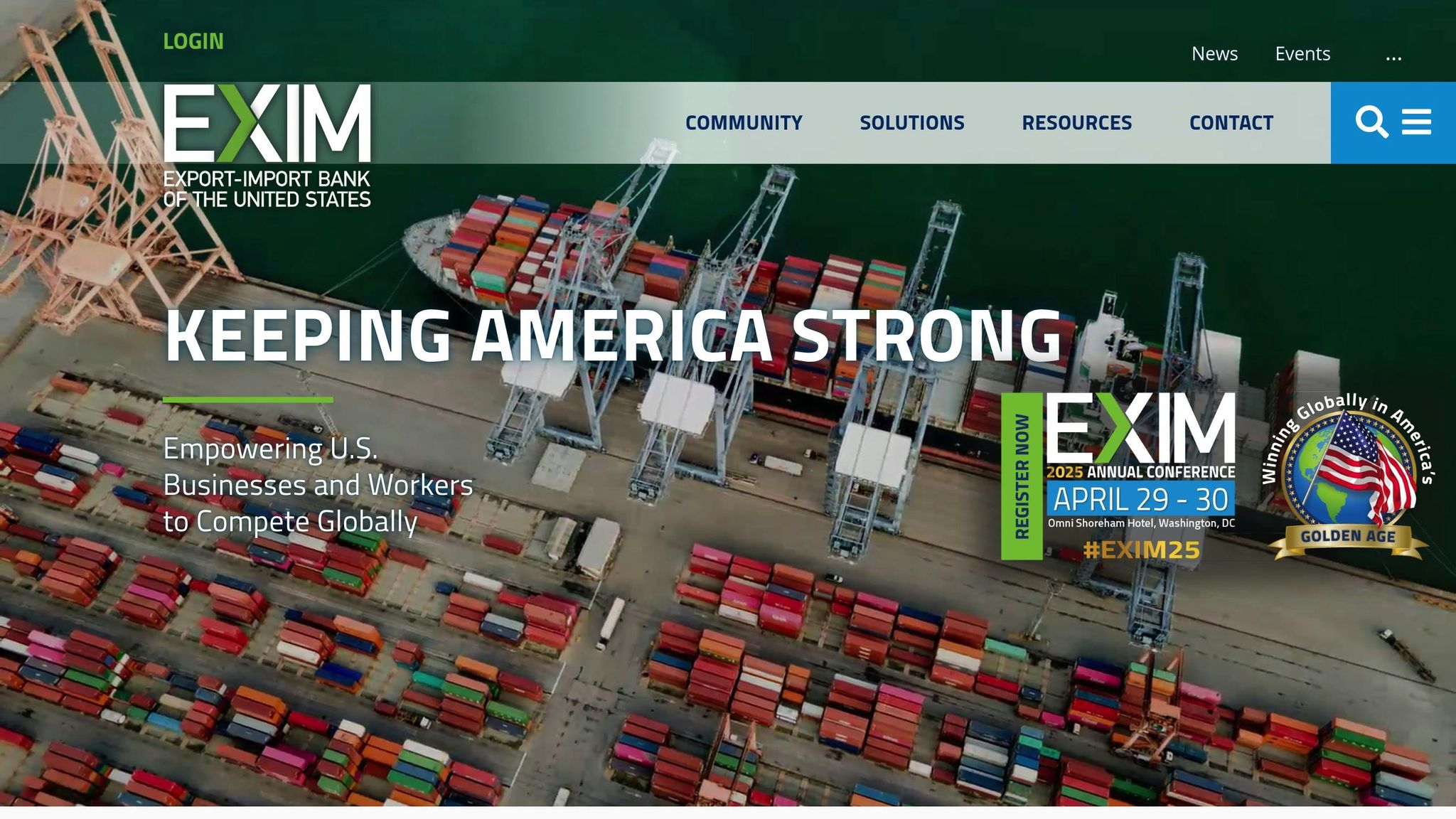Export Credit Insurance (ECI) is a safety net for U.S. businesses trading internationally. It protects exporters against non-payment risks, whether due to a buyer’s financial troubles or political disruptions abroad. Here’s why it matters:
- Covers Risks: Protects up to 95% of invoice value from commercial (e.g., buyer bankruptcy) and political risks (e.g., war, terrorism).
- Boosts Confidence: Enables businesses to offer competitive credit terms to international buyers, expanding into global markets securely.
- Improves Financing: Insured receivables make banks more willing to offer better loans.
Quick Facts:
- Costs typically less than 1% of insured sales.
- Short-term coverage protects receivables for up to 360 days.
- Medium-term policies cover large contracts for up to 5 years.
Export Credit Insurance helps U.S. businesses grow globally while managing financial risks effectively.
Core Functions of Export Credit Insurance
Basic Process Overview
Export credit insurance helps U.S. exporters manage risks in international transactions. Here’s how it works:
Policy Application and Setup
- Provide business details and export history.
- Select coverage types based on target markets and buyer profiles.
- Undergo an underwriting assessment.
- Review and accept policy terms after approval.
Ongoing Management
- Submit monthly shipment reports.
- Keep track of buyer credit limits and terms.
- Update the policy as needed.
- Pay premiums based on export volume.
Once the policy is in place, it offers coverage tailored to the unique needs of exporters.
Types of Coverage
Export credit insurance provides protection against common risks in global trade. Below is a breakdown of the main coverage types:
| Coverage Type | Protection Level | Duration | Typical Applications |
|---|---|---|---|
| Short-term Commercial | Up to 95% | 180 days | Consumer goods, materials |
| Short-term Capital | Up to 95% | 360 days | Small capital goods |
| Medium-term | 85% | Up to 5 years | Large capital equipment |
| Political Risk | Up to 95% | Policy term | All qualified exports |
Case Study: ECI Application
Let’s look at how this works in practice.
Company Profile:
A U.S.-based industrial equipment manufacturer began exporting to emerging markets in 2024. The company needed to offer competitive payment terms while safeguarding against the risk of payment defaults.
Solution Implementation:
- Selected EXIM’s Express Insurance plan.
- Secured coverage for 95% of invoice value.
- Paid a premium of $0.65 per $100 for 60-day payment terms.
- Complied with monthly shipment reporting requirements.
Results:
- Protected $10 million in receivables.
- Extended payment terms from 30 to 60 days, making offers more appealing to buyers.
- Boosted international sales by providing better terms.
- Ensured stable cash flow with secured receivables.
This structured approach enables U.S. exporters to grow their global reach while managing financial risks effectively. The variety of coverage options and flexible terms make it easier for businesses to align their protection with their trade goals and risk levels.
How it Works: EXIM Bank Export Credit Insurance
Key Advantages for U.S. Exporters
The protections outlined earlier form a strong foundation for U.S. export success. Let’s dive into how these benefits work.
Payment Protection
Export credit insurance safeguards up to 95% of short-term and 85% of medium-term invoice values, protecting U.S. exporters from risks like buyer defaults or political disruptions.
| Risk Type | Protection Focus |
|---|---|
| Commercial | Protection against buyer defaults |
| Political | Coverage for international events |
This protection allows exporters to focus on growing their business without worrying about payment risks.
Market Expansion Support
Export credit insurance makes it easier for U.S. exporters to enter new markets while offering open account terms. This builds trust with international buyers and opens doors to:
- Safer entry into emerging markets
- Stronger relationships with overseas buyers
- Consistent cash flow for operations
"Export Credit Insurance is a powerful tool for U.S. exporters. It equips U.S. businesses to enter new markets without the fear of foreign customer nonpayment, extend competitive trade credit terms, and access more attractive receivables financing." – EXIM
By reducing risk, exporters can expand globally with greater confidence while maintaining steady cash flow.
Improved Financing Options
Having insured foreign receivables strengthens access to working capital and improves borrowing base calculations. This leads to better borrowing terms, more predictable cash flow, and lower risks from bad debts.
"When EXIM backs your foreign receivables, private lenders are often willing to lend against assets otherwise excluded from the borrowing base. The bottom line for your business: same collateral, a larger borrowing base, and a better cash flow." – EXIM.GOV
These financial advantages make it easier for U.S. exporters to scale their international operations effectively.
sbb-itb-b840488
Choosing an ECI Policy
Picking the right export credit insurance (ECI) policy means balancing your risk tolerance with your business objectives. Here’s how to approach the decision.
Selection Criteria
Start by evaluating your company’s specific needs. Use these key points to guide your assessment:
| Criteria | Considerations |
|---|---|
| Sales Volume | Annual export revenue and growth projections |
| Buyer Profile | Number of buyers, credit terms, and payment history |
| Market Risk | Political stability and economic conditions |
| Coverage Needs | Short-term (up to 360 days) vs. medium-term (up to 5 years) |
Analyze your export history to ensure your coverage matches your risk exposure. Once you’ve identified your needs, compare policy options that align with these criteria.
Available Policy Options
Export credit insurance policies are typically structured in two main ways to suit different business models:
- Sales-Based Policies
These policies grow with your business. Multi-buyer policies often cost less than 1% of your sales. - Coverage-Based Policies
Designed for consistent sales volumes, these policies provide:- Protection against buyer insolvency
- Coverage for political risks
- Predetermined coverage limits
"ECI should be a proactive purchase, in that exporters should obtain coverage before a customer becomes a problem." – trade.gov
After choosing a policy type, the next step is finding the right provider.
Insurance Provider Selection
When comparing providers, focus on these factors:
- Private Insurers: These providers often offer flexible limits and may lower premiums for experienced exporters.
- EXIM Bank: Ideal for coverage in high-risk or emerging markets where private insurers may not operate.
A specialized broker can help you identify the most cost-effective option. Premium rates from private insurers are influenced by factors like your export experience, buyer creditworthiness, market conditions, and the specifics of your coverage.
Keep in mind, EXIM Bank policies require products to have at least 50% U.S. content and be shipped from the United States, which may limit eligibility for certain businesses.
Policy Setup and Management
Initial Setup Process
Start by evaluating your export volume and the potential risks associated with your buyers. Here’s a breakdown of the key steps:
| Setup Phase | Key Actions |
|---|---|
| Assessment | Calculate the amount of sales you can insure and identify buyer risk levels. |
| Quote Review | Compare premium rates (typically $0.20–$0.30 per $100 of export sales). |
| Documentation | Collect financial records and buyer details. |
| Implementation | Activate and finalize your policy. |
"By law, you will pay the same rates for the coverage you choose, whether you use a broker or work directly with the insurance company. However, a broker can be a valuable resource, helping you evaluate quotes, implement your new accounts receivable insurance policy, and navigate mandatory reporting requirements. They may also assist with future claim submissions."
Once your policy is active, make adjustments as your business needs evolve.
Regular Policy Updates
As your business grows or changes, your export credit insurance should keep up. Adjust coverage to reflect shifts in buyer credit limits, payment behaviors, and overall market conditions. Regularly reviewing these factors ensures your policy remains aligned with your export activity.
Available Support Resources
Managing updates and adjustments doesn’t have to be overwhelming. Credit insurance brokers can provide key support, including:
- Comparing and evaluating quotes
- Offering guidance on implementing your policy
- Helping with reporting obligations
- Assisting with claims submission
"Working with a specialist can help you determine the best custom solution for your unique needs."
Maintain detailed records of buyer payment histories, credit limit usage, claims, and any policy changes. Staying proactive and maintaining clear communication with your broker or insurance provider will help ensure your coverage continues to meet your business goals.
Conclusion
Export Credit Insurance (ECI) offers crucial protection for U.S. businesses venturing into international markets. It safeguards exporters by covering up to 95% of sales invoices, reducing the risks tied to global trade.
For most businesses, the cost is relatively low – multi-buyer policies typically amount to less than 1% of insured sales. This coverage provides financial security by addressing both commercial and political risks, offering benefits such as:
- More appealing receivables for lenders
- Support for entering new markets
- The ability to offer competitive open account terms
FAQs
How does Export Credit Insurance help U.S. businesses offer better payment terms to international buyers?
Export Credit Insurance allows U.S. businesses to provide flexible and competitive open account payment terms to international buyers without exposing themselves to the risk of non-payment. By safeguarding accounts receivable, it gives businesses the confidence to extend favorable terms, making their offerings more attractive in the global market.
This financial protection not only helps mitigate potential losses but also supports business growth by enabling companies to build stronger relationships with international customers and expand into new markets with less financial uncertainty.
What should U.S. exporters consider when deciding between short-term and medium-term export credit insurance?
When deciding between short-term and medium-term export credit insurance, U.S. exporters should evaluate the repayment terms they offer to their international buyers and the nature of the goods being exported.
Short-term policies are generally suited for transactions involving consumer goods, raw materials, and services with repayment periods of up to 180 days. They may also cover small capital goods, consumer durables, and bulk commodities with repayment terms of up to 360 days.
Medium-term policies, on the other hand, are typically designed for larger capital equipment or machinery, with repayment periods ranging from one to five years. Exporters should also assess the buyer’s creditworthiness and the overall risk profile of the transaction to ensure the policy aligns with their business goals and financial needs.
How can U.S. businesses keep their Export Credit Insurance policies up-to-date with changing buyer risks and market conditions?
To keep your Export Credit Insurance policy current, it’s important to regularly assess buyer risks and market conditions. Monitor factors like your buyers’ financial health, geopolitical changes, and economic trends that might impact trade. Adjust your policy coverage as needed to reflect these changes and safeguard your accounts receivable.
Consider reviewing your policy annually or whenever significant market shifts occur. You can customize your coverage options – such as single-buyer or multi-buyer policies – to fit your business goals. For additional support, consult with an export finance specialist who can help you tailor your policy to changing circumstances. Staying proactive ensures your business remains protected while expanding internationally.



